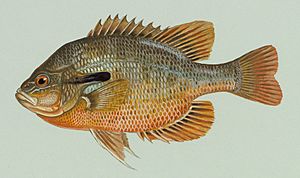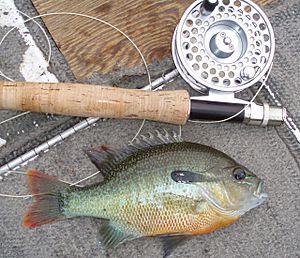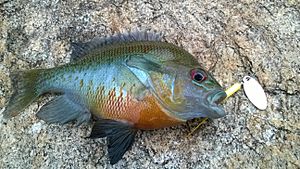Redbreast sunfish facts for kids
Quick facts for kids Redbreast sunfish |
|
|---|---|
 |
|
| Conservation status | |
| Scientific classification | |
| Synonyms | |
|
The redbreast sunfish (Lepomis auritus) is a type of freshwater fish. It belongs to the sunfish family, called Centrarchidae. This fish is naturally found in rivers in eastern Canada and the United States.
Redbreast sunfish can grow up to about 30 centimeters (12 inches) long. The heaviest one ever recorded weighed about 2.3 pounds. They like to live in places with lots of plants and rocks, like calm pools and the edges of lakes.
These fish eat insects, snails, and other small creatures without backbones. Many people enjoy catching redbreast sunfish. Some people also keep them as aquarium pets. Anglers often use live bait like nightcrawlers, crickets, grasshoppers, waxworms, or mealworms. Small lures or flies can also work. They are popular with fly fishers in winter because they bite more easily than bluegills when the water is cold.
Like other sunfish, the female redbreast sunfish lays her eggs in a nest built by the male. She lays about 1000 eggs. The male then stays to protect the eggs and the baby fish (called fry).
The redbreast sunfish has been moved to other countries like Germany, Italy, Mexico, and Puerto Rico. Sometimes, this can cause problems for the fish species that already live there. The name auritus means "big-eared" in Latin, which describes their long ear flaps.
Contents
What Does a Redbreast Sunfish Look Like?
Redbreast sunfish are found in the eastern United States and Canada. They live in rivers that flow into the Atlantic Ocean. Some have also been introduced as far west as Texas.
These fish mostly eat small insect larvae, tiny crayfish, and sometimes even smaller fish. They do well in streams and rivers that have places to hide, like around banks. The water usually has a pH level of about 7.0 to 7.5, which is slightly neutral.
Where Do Redbreast Sunfish Live?
The redbreast sunfish prefers cooler rivers, but you can also find them in freshwater lakes and streams. Their natural home covers a large area. They have also been introduced to places like Louisiana and West Texas. These new areas are usually not too far from where they naturally live.
How Do Redbreast Sunfish Live?
Sunfish like to be near banks and overhanging branches. These spots offer shade, food, and protection from predators. They survive best in water that has a current and a pH between 7.0 and 7.5. If the water doesn't move enough, or if it's too acidic or basic, it can be hard for them to survive.
Things that humans do can also affect sunfish. For example, clearing away plants and debris from river banks can let in more sunlight. This can make the water warmer and remove places for the fish to hide.
Redbreast Sunfish Life Cycle and Reproduction
Redbreast sunfish usually lay their eggs in the spring. They choose sandy or gravelly spots when the water temperature is between 16 and 26 degrees Celsius. The male fish builds a nest in shallow water. Sometimes, he might even use a nest that another fish has left behind.
The female fish comes to the nest and lays her sticky eggs. After she lays the eggs, she leaves. The male stays behind to guard the eggs and fan them with his fins. He might even protect the young fish for a short time after they hatch. Both male and female sunfish can breed with more than one partner.
A female sunfish lays about 2000 eggs on average, depending on her age. The eggs are about 1.1 millimeters wide. Redbreast sunfish can start having babies when they are two years old. They can live for about seven years, especially the males.
Redbreast Sunfish and People
Fishing for Redbreast Sunfish
The biggest redbreast sunfish ever caught on a fishing rod weighed 0.79 kilograms (1 pound, 12 ounces). This record fish was caught in the Suwannee River in Florida in 1984.
Images for kids
-
Typical redbreast sunfish from the Tallapoosa River, Alabama








